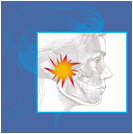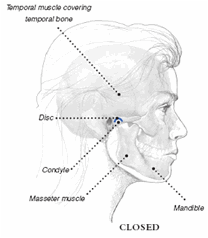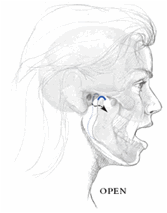TMJ Disorders
 Temporomandibular joint and muscle disorders, commonly called “TMJ,” are a group of conditions that cause pain and dysfunction in the jaw joint and the muscles that control jaw movement. We don’t know for certain how many people have TMJ disorders, but some estimates suggest that over 10 million Americans are affected. The condition appears to be more common in women than men.
Temporomandibular joint and muscle disorders, commonly called “TMJ,” are a group of conditions that cause pain and dysfunction in the jaw joint and the muscles that control jaw movement. We don’t know for certain how many people have TMJ disorders, but some estimates suggest that over 10 million Americans are affected. The condition appears to be more common in women than men.
For
most people, pain in the area of the jaw joint or muscles does not signal a
serious problem. Generally, discomfort from these conditions is occasional and
temporary, often occurring in cycles. The pain eventually goes away with little
or no treatment. Some people, however, develop significant, long-term symptoms.
If you have questions about TMJ disorders, you are not alone. Researchers, too,
are looking for answers to what causes these conditions and what are the best
treatments. Until we have scientific evidence for safe and effective
treatments, it’s important to avoid, when possible, procedures that can cause
permanent changes in your bite or jaw. This booklet provides information you
should know if you have been told by a dentist or physician that you have a TMJ
disorder.
What is the temporomandibular joint?
The temporomandibular joint connects the lower jaw, called the mandible, to the bone at the side of the head—the temporal bone. If you place your fingers just in front of your ears and open your mouth, you can feel the joints. Because these joints are flexible, the jaw can move smoothly up and down and side to side, enabling us to talk, chew and yawn. Muscles attached to and surrounding the jaw joint control its position and movement.


When we open our mouths, the rounded ends of the lower jaw, called condyles, glide along the joint socket of the temporal bone. The condyles slide back to their original position when we close our mouths. To keep this motion smooth, a soft disc lies between the condyle and the temporal bone. This disc absorbs shocks to the jaw joint from chewing and other movements.
The temporomandibular joint is different from the body’s other joints. The combination of hinge and sliding motions makes this joint among the most complicated in the body. Also, the tissues that make up the temporomandibular joint differ from other load-bearing joints, like the knee or hip. Because of its complex movement and unique makeup, the jaw joint and its controlling muscles can pose a tremendous challenge to both patients and health care providers when problems arise.
What are TMJ disorders?
Disorders of the jaw joint and chewing muscles—and how people respond to them—vary widely. Researchers generally agree that the conditions fall into three main categories:
- Myofascial pain, the most common temporomandibular disorder, involves discomfort or pain in the muscles that control jaw function.
- Internal derangement of the joint involves a displaced disc, dislocated jaw, or injury to the condyle.
- Arthritis refers to a group of degenerative/inflammatory joint disorders that can affect the temporomandibular joint.
A person may have one or more of these conditions at the same time. Some people have other health problems that coexist with TMJ disorders, such as chronic fatigue syndrome, sleep disturbances or fibromyalgia, a painful condition that affects muscles and other soft tissues throughout the body. It is not known whether these disorders share a common cause.
People who have a rheumatic disease, such as rheumatoid arthritis, may develop TMJ disease as a secondary condition. Rheumatic diseases refer to a large group of disorders that cause pain, inflammation, and stiffness in the joints, muscles, and bone. Both rheumatoid arthritis and some TMJ disorders involve inflammation of the tissues that line the joints. The exact relationship between these conditions is not known.
How jaw joint and muscle disorders progress is not clear. Symptoms worsen and ease over time, but what causes these changes is not known. Most people have relatively mild forms of the disorder. Their symptoms improve significantly, or disappear spontaneously, within weeks or months. For others, the condition causes long-term, persistent and debilitating pain.
What causes TMJ disorders?
Trauma to the jaw or temporomandibular joint plays a role in some TMJ disorders. But for most jaw joint and muscle problems, scientists don’t know the causes. For many people, symptoms seem to start without obvious reason. Research disputes the popular belief that a bad bite or orthodontic braces can trigger TMJ disorders. Because the condition is more common in women than in men, scientists are exploring a possible link between female hormones and TMJ disorders.
There is no scientific proof that clicking sounds in the jaw joint lead to serious problems. In fact, jaw clicking is common in the general population. Jaw noises alone, without pain or limited jaw movement, do not indicate a TMJ disorder and do not warrant treatment.
The roles of stress and tooth grinding as major causes of TMJ disorders are also unclear. Many people with these disorders do not grind their teeth, and many long-time tooth grinders do not have painful joint symptoms. Scientists note that people with sore, tender chewing muscles are less likely than others to grind their teeth because it causes pain. Researchers also found that stress seen in many persons with jaw joint and muscle disorders is more likely the result of dealing with chronic jaw pain or dysfunction than the cause of the condition.
A variety of symptoms may be linked to TMJ disorders. Pain, particularly in the chewing muscles and/or jaw joint, is the most common symptom. Other likely symptoms include:
- radiating pain in the face, jaw, or neck,
- jaw muscle stiffness,
- limited movement or locking of the jaw,
- painful clicking, popping or grating in the jaw joint when opening or closing the mouth,
- a change in the way the upper and lower teeth fit together.
How are TMJ disorders diagnosed?
There is no widely accepted, standard test now available to correctly diagnose TMJ disorders. Because the exact causes and symptoms are not clear, identifying these disorders can be difficult and confusing. Currently, health care providers note the patient’s description of symptoms, take a detailed medical and dental history, and examine problem areas, including the head, neck, face, and jaw. Imaging studies may also be recommended.
You may want to consult your doctor to rule out known causes of pain. Facial pain can be a symptom of many other conditions, such as sinus or ear infections, various types of headaches, and facial neuralgias (nerve-related facial pain). Ruling out these problems first helps in identifying TMJ disorders.
How are TMJ disorders treated?
Because more studies are needed on the safety and effectiveness of most treatments for jaw joint and muscle disorders, experts strongly recommend using the most conservative, reversible treatments possible. Conservative treatments do not invade the tissues of the face, jaw, or joint, or involve surgery. Reversible treatments do not cause permanent changes in the structure or position of the jaw or teeth. Even when TMJ disorders have become persistent, most patients still do not need aggressive types of treatment.
Conservative Treatments
Because the most common jaw joint and muscle problems are temporary and do not get worse, simple treatment is all that is usually needed to relieve discomfort.
Self-Care Practices
There are steps you can take that may be helpful in easing symptoms, such as:
- eating soft foods,
- applying ice packs,
- avoiding extreme jaw movements (such as wide yawning, loud singing, and gum chewing),
- learning techniques for relaxing and reducing stress,
- practicing gentle jaw stretching and relaxing exercises that may help increase jaw movement. Your health care provider or a physical therapist can recommend exercises if appropriate for your particular condition.
Pain Medications
For many people with TMJ disorders, short-term use of over-the-counter pain medicines or nonsteroidal anti-inflammatory drugs (NSAIDS), such as ibuprofen, may provide temporary relief from jaw discomfort. When necessary, your dentist or doctor can prescribe stronger pain or anti-inflammatory medications, muscle relaxants, or anti-depressants to help ease symptoms.
Stabilization Splints
Your doctor or dentist may recommend an oral appliance, also called a stabilization splint or bite guard, which is a plastic guard that fits over the upper or lower teeth. Stabilization splints are the most widely used treatments for TMJ disorders. Studies of their effectiveness in providing pain relief, however, have been inconclusive. If a stabilization splint is recommended, it should be used only for a short time and should not cause permanent changes in the bite. If a splint causes or increases pain, stop using it and see your health care provider.
The conservative, reversible treatments described are useful for temporary relief of pain – they are not cures for TMJ disorders. If symptoms continue over time, come back often, or worsen, tell your doctor.
Botox
Botox™ (botulinum toxin type A) is a drug made from the same bacterium that causes food poisoning. Used in small doses, Botox injections can actually help alleviate some health problems. The Food and Drug Administration (FDA) has approved Botox for the treatment of certain eye muscle disorders, cervical dystonia (neck muscle spasms), and severe underarm sweating, as well as for limited cosmetic use. Botox has not been approved by the FDA for use in TMJ disorders. Research is under way to learn how Botox specifically affects jaw muscles and their nerves. The findings will help determine if this drug may be useful in treating TMJ disorders.
Irreversible Treatments
Irreversible treatments that have not been proven to be effective – and may make the problem worse – include orthodontics to change the bite; crown and bridge work to balance the bite; grinding down teeth to bring the bite into balance, called “occlusal adjustment”; and repositioning splints, also called orthotics, which permanently alter the bite.
Surgery
Other types of treatments, such as surgical procedures, invade the tissues. Surgical treatments are controversial, often irreversible, and should be avoided where possible. There have been no long-term clinical trials to study the safety and effectiveness of surgical treatments for TMJ disorders. Nor are there standards to identify people who would most likely benefit from surgery. Failure to respond to conservative treatments, for example, does not automatically mean that surgery is necessary. If surgery is recommended, be sure to have the doctor explain to you, in words you can understand, the reason for the treatment, the risks involved, and other types of treatment that may be available.

